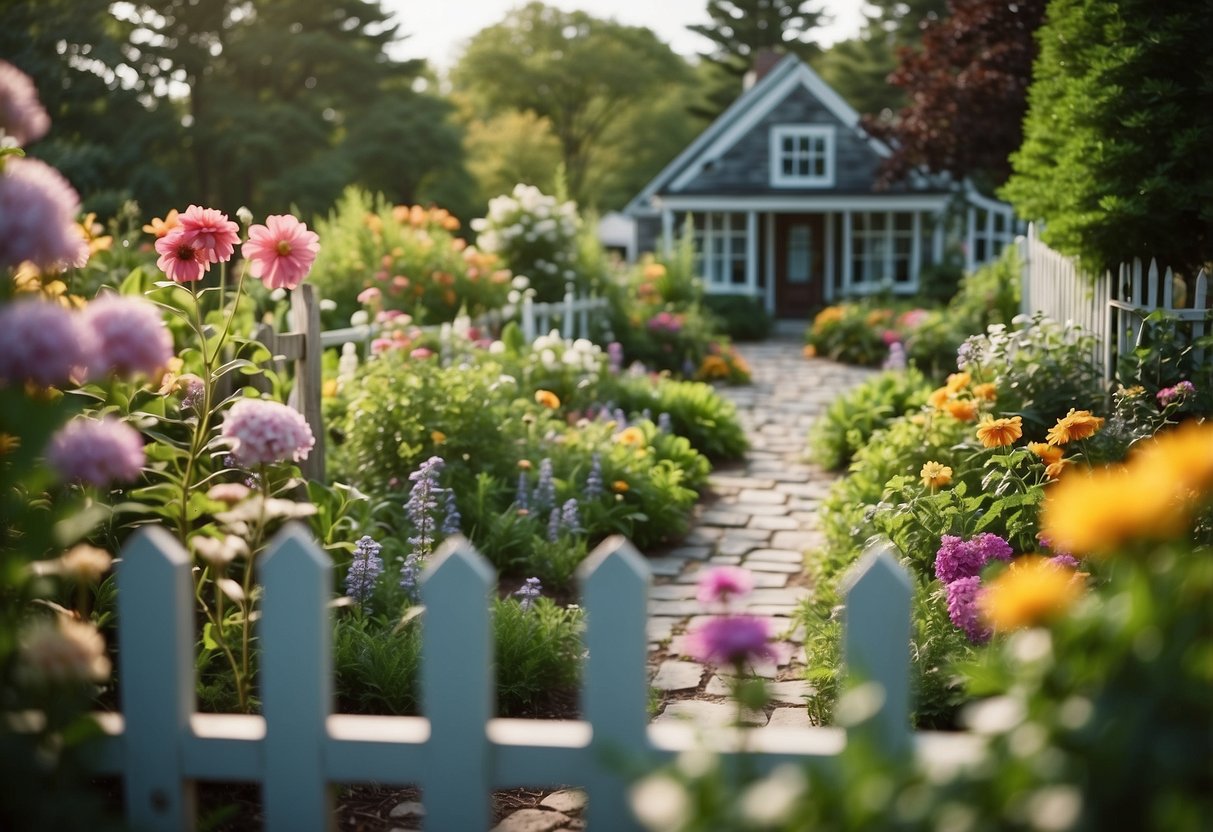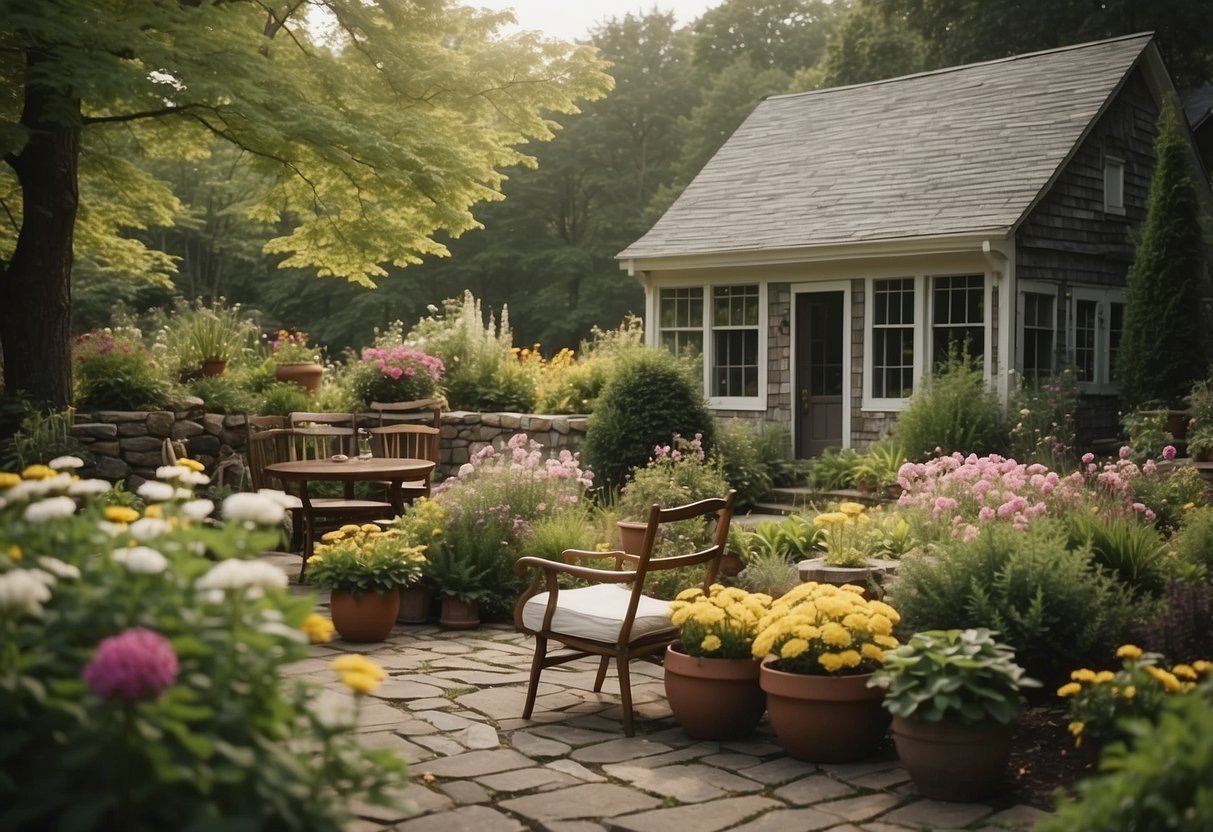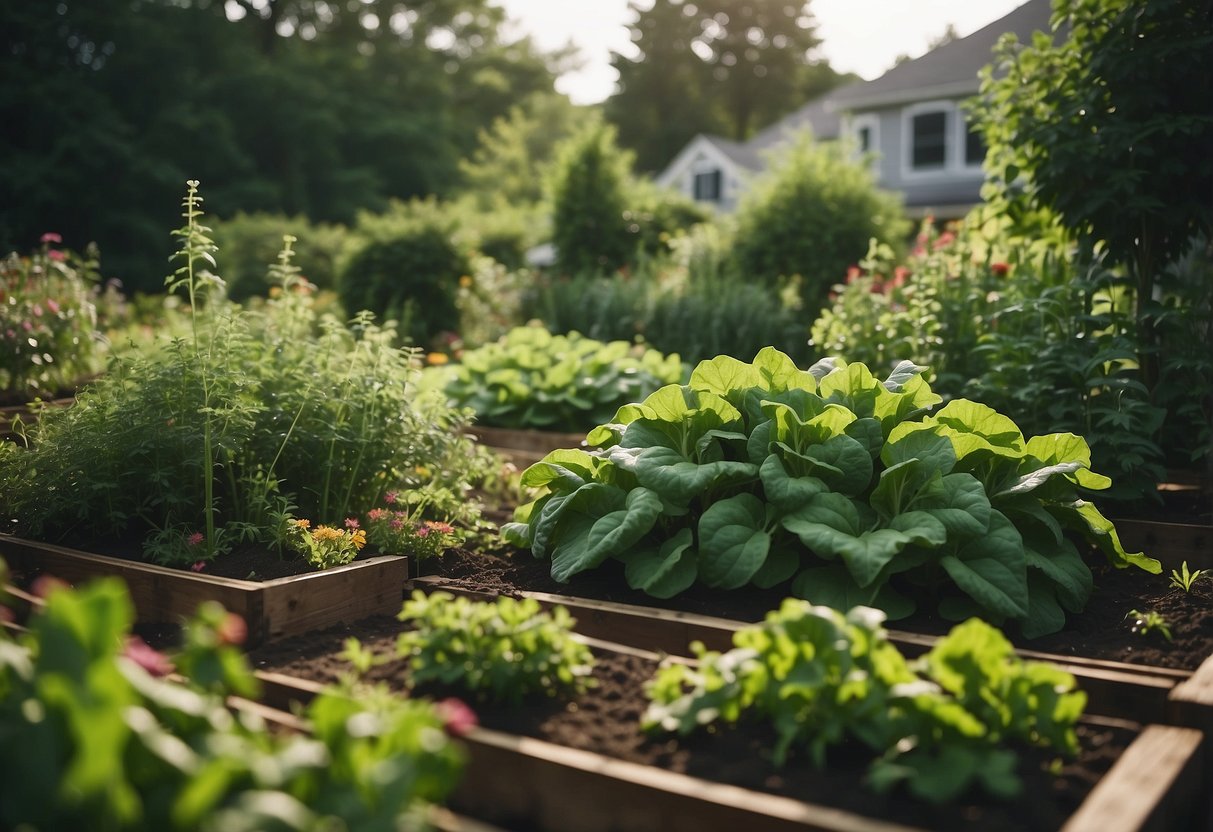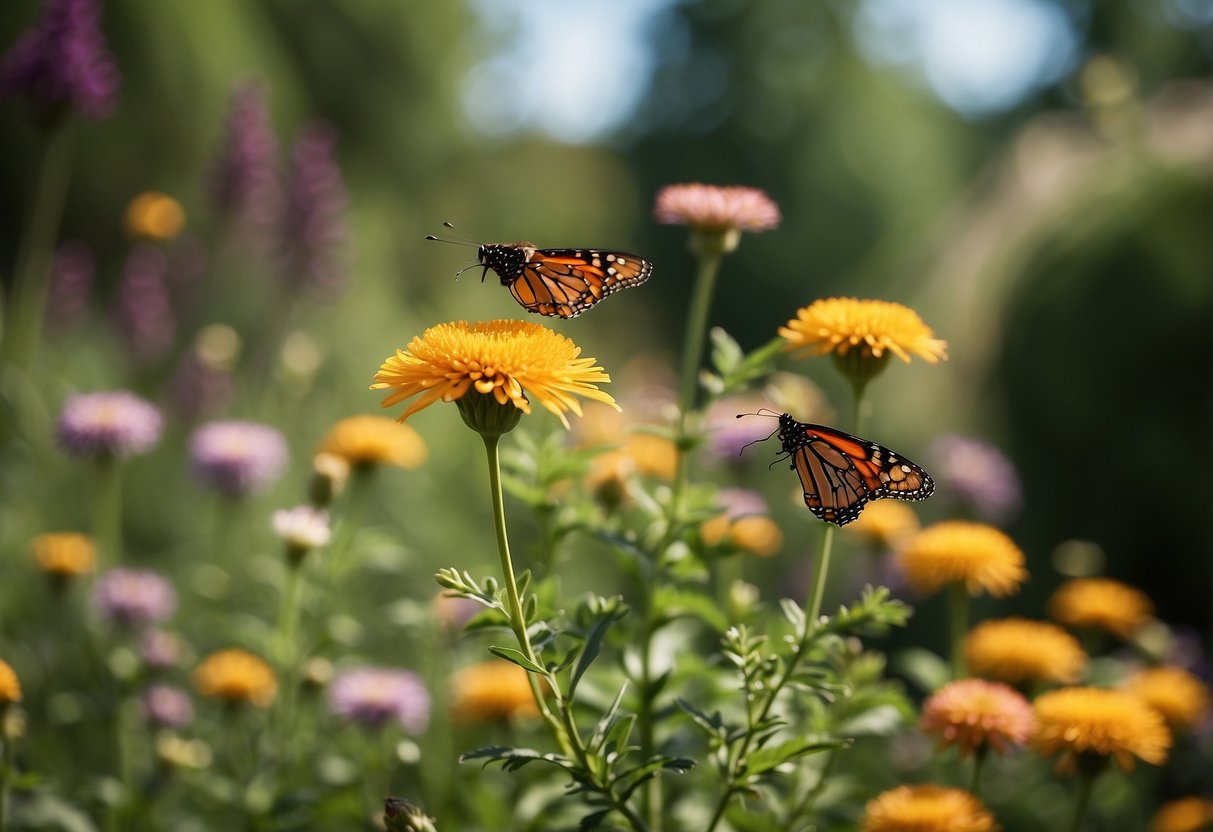New England Garden Ideas: Charming Designs for Your Outdoor Space
Planning a garden in New England can be a delightful experience, given the region’s unique climate and diverse seasons. From vibrant spring blossoms to colorful fall foliage, there is something truly magical about cultivating a garden in this part of the country.

What plants work best in New England gardens? This guide will offer you practical ideas and inspiration to make the most of your garden throughout the year. Whether you are a seasoned gardener or just starting out, you will find useful tips to create your own beautiful and thriving New England garden.
1) Raised Herb Gardens

Raised herb gardens are a wonderful way to grow herbs in New England. They allow for better soil control, which means your herbs can thrive.
Most herbs need at least a foot of soil to grow. Basil and rosemary might need even more, so make sure your raised bed is deep enough.
The raised structure also helps with drainage, preventing waterlogged roots. This is crucial for herbs like thyme and mint. For more ideas on raised herb gardens, check out Epic Gardening.
2) Perennial Flower Borders

Perennial flower borders are a wonderful addition to any New England garden. These flowers come back year after year, providing a burst of color and life from spring to fall. They are perfect for creating a lively edge along paths or garden beds.
Consider adding Eastern Bluestar, which offers beautiful blue flowers in spring and golden foliage in fall. Plumbago is another great choice, known for its stunning sky-blue flowers and sweet aroma. Both of these options are easy to grow and low-maintenance, making them ideal for any gardener.
3) Water Features

Adding a water feature can bring peace and beauty to your New England garden. A narrow garden pool adds a sleek, modern touch.
You can also create a small pond or a birdbath to invite wildlife. These elements can keep your garden lively and vibrant.
Lastly, consider a simple fountain. Its gentle sound can make your garden a relaxing retreat. Your garden will feel more serene and inviting with these water features.
4) English Cottage Garden

Creating an English cottage garden in New England can bring charm and color to your landscape. These gardens are known for their whimsical and lush appearance. You can achieve this look by planting a mix of bright perennials and adding textures with shrubs and trees.
Include classic flowers like roses, hollyhocks, and coneflowers. These plants will thrive and provide a timeless cottage feel. Consider adding ornamental grasses to create variety in height and movement within your garden.
Don’t be afraid to mix and match different plants. Experiment with succulents, jasmine, or perennial grasses for a unique twist. Plant in a relaxed, informal pattern for that cozy, inviting look. Learn more about ideas from this site and this one. Happy gardening!
5) Vertical Gardens

If you’re short on space, vertical gardens are perfect for you. You can use planters on a wall or fence to grow flowers and veggies.
A fun idea is to reuse old bottles as planters. Paint them, cut them, and hang them with rope or twine.
A wooden slat wall is another stylish option. Attach planters to it and brighten up your garden!
For more tips, visit Good Housekeeping’s vertical garden ideas.
Create a green oasis with vertical planters and turn your small garden into a lush paradise!
6) Rustic Garden Furniture

Rustic garden furniture adds charm to any New England garden. Think about incorporating wooden benches and stone seats.
Pieces like these provide comfortable places to relax.
Look for vintage items such as old washboards or stone jars, which can double as decor. They enhance the rustic feel and create inviting spots within your garden.
Explore more ideas here.
7) Native Plant Landscaping

Using native plants in your garden helps the environment and brings natural beauty to your yard.
Plants like the Carolina lupine, which has showy pea-like flowers, can thrive in your outdoor space. For more info, see Better Homes & Gardens’ 15 Top Native Plants of the Northeast.
Joining organizations like Wild Ones can give you more tips and resources for creating a native plant garden. This group focuses on environmentally sound landscaping practices.
8) Fairy Garden Corners

Creating a fairy garden corner adds a touch of magic to your New England garden. Start with a small container or a dedicated space in your garden bed. Choose tiny plants like succulents and moss to create a lush, whimsical atmosphere.
Add fairy-sized accessories such as tiny houses, figurines, and miniature furniture. You can also incorporate elements like twig wreaths and tiny mushrooms. For more ideas, check out fairy garden corner ideas.
Fill in the space with colorful, blooming plants and creeping vines to enhance the enchanting look.
9) Seasonal Vegetable Patches

Creating seasonal vegetable patches in New England is a great way to enjoy fresh produce year-round. Plant hearty vegetables like kale and carrots in the fall, which can withstand the cooler temperatures.
Spring is perfect for planting lettuce and peas, which thrive in the milder weather. Summer offers opportunities to grow tomatoes and zucchini, which love the warmer days.
Using raised beds can help manage the rocky soil common in New England, enhancing your garden’s success. Try rotating your crops each season to keep the soil healthy and your garden vibrant.
10) Pollinator-Friendly Plants

Creating a garden with pollinator-friendly plants can make your outdoor space vibrant and lively. Start by including native plants like Black-Eyed Susans and Bee Balm. These attract bees and butterflies.
Consider planting milkweed for monarch butterflies. Adding herbs such as lavender and mint will also draw in various pollinators. To keep your garden blooming, choose flowers that blossom throughout the spring, summer, and fall.
Ensure you have a mix of colors, shapes, and sizes to cater to different pollinators. Your garden will not only look beautiful but also support the environment. For more ideas, check this guide.
Designing Your New England Garden

Creating a garden in New England involves planning for the changing seasons and selecting plants that thrive in its unique climate. You will need to understand the climate and choose appropriate plants for year-round beauty.
Understanding New England Climate
In New England, the climate is characterized by cold winters, warm summers, and unpredictable weather. This region spans states like Connecticut, Massachusetts, and Rhode Island. Winters can be harsh with heavy snowfall and freezing temperatures. Summers are warm but can sometimes feel humid.
Spring often brings late frosts, so it’s essential to choose hardy plants. Fall is known for its stunning foliage, which adds vibrant colors to your garden. Knowing these seasonal patterns helps you plan when to plant and what maintenance routines to follow. Gardens need to withstand these fluctuations to flourish throughout the year.
Choosing the Right Plants
Selecting the right plants is crucial for a successful garden. Lilacs are popular for their fragrant, purple blooms and thrive in the cool climate of New England. Sugar maples are a classic choice, providing beautiful fall foliage and the potential for maple syrup. For shady areas, consider planting astilbes; their feathery plumes and fern-like foliage add texture and color.
Garden design ideas also include incorporating other hardy plants like roses, hostas, and daylilies. Using local plants ensures they are well-suited to the weather and soil conditions. Additionally, plan for some winter interest by including evergreens like boxwood or holly. Keep your garden enchanting through every season with a balanced mix of flowers, shrubs, and trees.
Essential Tips for a Flourishing New England Garden

Maintaining a beautiful garden in New England requires specific practices suited to its unique climate. Remember to focus on preparing the soil, setting up proper irrigation, and performing essential seasonal tasks.
Soil Preparation and Testing
Good soil is the foundation of any thriving garden. Start by testing your soil to understand its pH levels and nutrient content. You can use a DIY kit or send a sample to a local extension service. Adjust the soil pH by adding lime to raise it or sulfur to lower it.
New England soil is often acidic, so lime might be necessary. Adding compost or aged manure enhances soil structure and fertility. Consider mixing in organic matter such as leaves or grass clippings to improve drainage and water retention.
Aerating the soil is also important. You can do this by tilling or by using a garden fork to break up compacted areas. This makes it easier for roots to grow and for water and nutrients to penetrate.
Watering and Irrigation
Proper watering is crucial for plant health. In New England, you need to account for the variable weather. Drip irrigation systems are very effective, delivering water slowly and directly to the plant roots.
Installing a soaker hose or using drip lines helps reduce water waste and prevents the leaves from getting wet, which can lead to fungal diseases.
Water early in the morning to minimize evaporation and allow leaves to dry before nightfall, reducing disease risks. Mulching around plants keeps the soil moist and cool. Consider using organic mulch like wood chips, straw, or pine needles.
Seasonal Maintenance
Each season brings its own set of tasks. Spring involves cleaning up debris, pruning damaged branches, and planting cool-season vegetables or flowers. As summer warms up, stay on top of watering and watch for pests and diseases, handling them promptly.
In fall, prepare for winter by clearing dead plants, adding compost, and planting bulbs for early spring blooms. Winter maintenance includes protecting plants from harsh winds with burlap or windbreaks and keeping an eye on snow buildup that could break branches.
Throughout the year, don’t forget regular weeding to prevent competition for nutrients. By staying consistent with these tasks, your garden will thrive in every season.







